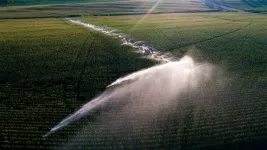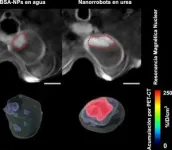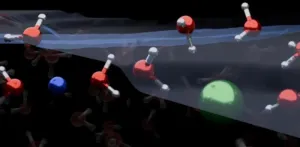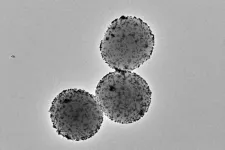(Press-News.org) Three decades of data have informed a new Nebraska-led study that shows how the depletion of groundwater — the same that many farmers rely on for irrigation — can threaten food production amid drought and drier climes.
The study found that, due in part to the challenges of extracting groundwater, an aquifer’s depletion can curb crop yields even when it appears saturated enough to continue meeting the demands of irrigation. Those agricultural losses escalate as an aquifer dwindles, the researchers reported, so that its depletion exerts a greater toll on corn and soybean yields when waning from, say, 100 feet thick to 50 than from 200 feet to 150.
That reality should encourage policymakers, resource managers and growers to reconsider the volume of crop-quenching groundwater they have at their disposal, the team said, especially in the face of fiercer, more frequent drought.
“As you draw down an aquifer to the point that it’s quite thin, very small changes in the aquifer thickness will then have progressively larger and larger impacts on your crop production and resilience,” said Nick Brozović, director of policy at the Daugherty Water for Food Global Institute. “And that’s a thing that we don’t predict well, because we tend to predict based on the past. So if we base what’s going to happen on our past experience, we’re always going to underpredict. We’re always going to be surprised by how bad things get.”
The team came to its conclusions after analyzing yields, weather and groundwater data from the High Plains Aquifer, which, as the largest in the United States, underlies portions of eight states — including nearly all of Nebraska. Some areas of the aquifer, especially those beneath Texas and Kansas but also the Cornhusker State, have diminished considerably over the past several decades, pumped for the sake of irrigating land that would otherwise stand little chance of sustaining crops.
“In terms of things that let you address food security under extreme conditions — in particular, drought and climate change — we really can’t do without irrigation,” said Brozović, professor of agricultural economics at the University of Nebraska–Lincoln. “If we want to feed the world with high-quality, nutritious food and a stable food supply, we need to irrigate.”
Brozović and Husker colleague Taro Mieno had already constructed plenty of models, and run plenty of simulations, on how the High Plains Aquifer responds to drought and dry conditions. But talking with farmers revealed that the models were not addressing their primary concern: well yield, or the amount of groundwater that growers can expect to continuously draw when trying to buffer their crops against drought.
“Everybody’s interested in how aquifer depletion affects the resiliency of irrigated agriculture in the region,” said Mieno, an associate professor of agricultural economics and lead author of the study, which was published in the journal Nature Water.
So the researchers consulted annual estimates of the High Plains Aquifer’s thickness, which date back to 1935, along with county-level yields of corn and soybean from 1985 through 2016. Meteorological data, meanwhile, allowed the team to calculate seasonal water deficits, or the difference between the water gained from precipitation and the amount that crops lost via evaporation and transpiration.
When the latter exceeds the former, farmers often turn to aquifers for help in making up the difference, the researchers knew. What they didn’t know: Under what conditions, and to what extent, would an aquifer’s depletion make pumping its water too difficult or expensive to undertake? And how much would the resulting decisions — to reduce the amount of irrigation per acre, to cease irrigating certain plots all together — influence corn and soybean yields?
Farmers fortunate enough to be growing corn and soybean above the most saturated swaths of the High Plains Aquifer — roughly 220 to 700 feet thick — continued to enjoy high irrigated yields even in times of extreme water deficits, the team found. By contrast, those depending on the least saturated areas — between 30 and 100 feet — saw their irrigated yields begin trending downward when water deficits reached just 400 millimeters, a common occurrence in Nebraska and other Midwestern states.
In years when the deficit approached or exceeded 700 millimeters, irrigated fields residing above the thickest groundwater yielded markedly more corn than those sitting above the thinnest. The results were starker during a 950-millimeter water deficit, which corresponds with extreme drought: Fields atop the least saturated stretches of aquifer yielded roughly 19.5 fewer bushels per acre.
“Because of the way that aquifers work, even if there’s a lot of water there, as they deplete, you actually lose the ability to meet those crop water needs during the driest periods, because well yield tends to decline as you deplete an aquifer,” Brozović said. “That has an economic consequence and a resilience consequence.”
The study captured another telling link between the water residing underground and that applied at the surface. When atop groundwater roughly 330 feet thick, farmers irrigated 89% of their acres dedicated to growing corn. Where the aquifer was a mere 30 feet thick? Just 70% of those acres received irrigation. That’s likely a result of lower well yield driving farmers to irrigate only some of their fields, Taro said, or even give up on irrigation.
To better understand how that reduced irrigation was contributing to agricultural losses amid dry conditions, the researchers then factored in yields from both irrigated and non-irrigated fields, the latter of which rely on precipitation alone. That analysis pegged yields as even more sensitive to even smaller water deficits, suggesting that the decline in irrigated land was compounding the losses endured on still-irrigated plots.
And it illustrated the runaway threat posed when an aquifer’s average thickness drops below certain thresholds. At a water deficit of 950 millimeters, reducing an aquifer’s thickness from roughly 330 to 230 feet was estimated to initiate an average loss of about 2.5 corn bushels per acre, what the authors called a “negligible difference.” The same absolute decrease, but from 230 to 130 feet, led to an estimated loss of 15 bushels per acre.
“As a consequence, your resilience to climate decreases rapidly,” Mieno said. “So when you’re operating on an aquifer that is very thick right now, you’re relatively safe. But you want to manage it in a way that you don’t go past that threshold, because from there, it’s all downhill.
“And the importance of aquifers is going to increase as climate change progresses in the future, for sure. As it gets hotter, you typically need more water. That means you need more irrigation, and you’re going to deplete the aquifer even faster, and things can get worse and worse.”
Nebraska is lucky, Brozović said, in that it sits above such a massive reservoir and has established a governance system designed to conserve it at a local scale. But most regulations focus on mandating how much and when groundwater gets pumped, not safeguarding the aquifer’s saturation level or the corresponding ability to extract water from it.
Brozović conceded that convincing policymakers to consider revising those parameters now, when much of the state still boasts sufficient groundwater, is “perhaps a tough sell.” He’s hopeful that the new study can at least help put that conversation on the table.
“Once you have a problem — once well yields are already declining and the aquifer’s really thin — even if you put in policies, you still get a lot of the (negative) impacts,” he said. “So the time to really put in meaningful policies is before things have gone off the cliff.
“First, you have to understand, you have to measure, you have to educate. You have to understand what you’re preserving, and why. The more you can provide the quantitative evidence for why it’s worth going to the trouble of doing all of this, and what’s at stake,” he said, “the easier that conversation is.”
Brozović and Mieno authored the Nature Water study with the University of Manchester’s Timothy Foster and the University of Minnesota’s Shunkei Kakimoto. The researchers received support in part from the U.S. Department of Agriculture.
END
Study quantifies how aquifer depletion threatens crop yields
Yield losses intensify when groundwater dwindles, data shows
2024-01-15
ELSE PRESS RELEASES FROM THIS DATE:
When bees nourish their microbiota
2024-01-15
Two teams from UNIL and EPFL have succeeded in demonstrating that the insect synthesizes nutrients for native gut microbes. A study published in « Nature Microbiology ».
Bacteria have adapted to all terrestrial environments. Some have evolved to survive in the gut of animals, where they play an important role for their host; they provide energy by degrading indigestible food, they train and regulate the immune system, they protect against invasion by pathogenic bacteria, and they synthesize neuroactive molecules that regulate the behavior and cognition of their host.
These are great ...
Accelerating how new drugs are made with machine learning
2024-01-15
Researchers have developed a platform that combines automated experiments with AI to predict how chemicals will react with one another, which could accelerate the design process for new drugs.
Predicting how molecules will react is vital for the discovery and manufacture of new pharmaceuticals, but historically this has been a trial-and-error process, and the reactions often fail. To predict how molecules will react, chemists usually simulate electrons and atoms in simplified models, a process which is computationally expensive and often inaccurate.
Now, researchers from the University of Cambridge ...
Water molecule discovery contradicts textbook models
2024-01-15
Textbook models will need to be re-drawn after a team of researchers found that water molecules at the surface of salt water are organised differently than previously thought.
Many important reactions related to climate and environmental processes take place where water molecules interface with air. For example, the evaporation of ocean water plays an important role in atmospheric chemistry and climate science. Understanding these reactions is crucial to efforts to mitigate the human effect on our planet.
The distribution of ions at the interface of air and water can affect atmospheric processes. However, a precise understanding of ...
U.S. air pollution rates on the decline but pockets of inequities remain
2024-01-15
Over the last decades, air pollution emissions have decreased substantially; however, the magnitude of the change varies by demographics, according to a new study by Columbia University Mailman School of Public Health. The results indicate there are racial/ethnic and socioeconomic disparities in air pollution emissions reductions, particularly in the industry and energy generation sectors. The findings are published in the journal Nature Communications.
The research provides a national investigation of air pollution emission changes in the 40 years following the enactment of the Clean Air ...
New Scientific Reports publication reveals major difference in genomes of American and Chinese chestnut
2024-01-15
The chromosomes of American and Chinese chestnut are not so similar after all, at least in one key region of the genome – the nucleolus organizing region (NOR).
The finding, published in a forthcoming article in Scientific Reports, has major implications for anyone with the goal of conferring blight-resistance to American chestnuts through hybridization with the Chinese chestnut.
“This is an unprecedented finding in the field of plant cytology,” says Nurul Faridi, a Forest Service geneticist and lead author of the study.
Traditional ...
Solid-state qubits: Forget about being clean, embrace mess
2024-01-15
New findings debunk previous wisdom that solid-state qubits need to be super dilute in an ultra-clean material to achieve long lifetimes. Instead, cram lots of rare-earth ions into a crystal and some will form pairs that act as highly coherent qubits, shows paper in Nature Physics.
Clean lines and minimalism, or vintage shabby chic? It turns out that the same trends that occupy the world of interior design are important when it comes to designing the building blocks of quantum computers.
How to make qubits that retain their quantum information long enough to be useful is one of the major barriers to practical quantum computing. It’s widely accepted that the ...
Bladder tumors reduced by 90% using nanorobots
2024-01-15
Bladder cancer has one of the highest incidence rates in the world and ranks as the fourth most common tumour in men. Despite its relatively low mortality rate, nearly half of bladder tumours resurface within 5 years, requiring ongoing patient monitoring. Frequent hospital visits and the need for repeat treatments contribute to making this type of cancer one of the most expensive to cure.
While current treatments involving direct drug administration into the bladder show good survival rates, their therapeutic efficacy remains low. A promising alternative involves the use of nanoparticles capable of delivering therapeutic agents directly to the tumour. ...
Research sheds new light on Moon rock formation solving major puzzle in lunar geology
2024-01-15
New research has cracked a vital process in the creation of a unique rock type from the Moon. The discovery explains its signature composition and very presence on the lunar surface at all, unravelling a mystery which has long eluded scientists.
The study, published today in Nature Geoscience, reveals a key step in the genesis of these distinctive magmas. A combination of high temperature laboratory experiments using molten rocks, together with sophisticated isotopic analyses of lunar samples, identify a critical reaction that controls their composition.
This reaction took place in the deep lunar interior some three and a half ...
Priming, shaping and polishing: In search of a HIV vaccine
2024-01-15
Worldwide, an estimated, 40 million people live with HIV. Two-thirds of this group on the African continent. In 2022, more than 600,000 people died from HIV-related causes and more than 1.3 million were infected. There is no vaccine against the world's second most deadly infection, after TB. Thanks to a grant from the Bill & Melinda Gates Foundation, Amsterdam UMC's Rogier Sanders leads a project that aims to develop the first effective HIV vaccine.
"We hope to be able ...
Vigilant monitoring is needed to manage cardiac risks in patients using antipsychotics, doctors say
2024-01-15
Philadelphia, January 15, 2024 – The use of the antipsychotic drugs quetiapine and haloperidol is associated with an increased risk of ventricular arrhythmias and sudden cardiac death (SCD) caused by drug-induced QT prolongation, reports a new study in Heart Rhythm, the official journal of the Heart Rhythm Society, the Cardiac Electrophysiology Society, and the Pediatric & Congenital Electrophysiology Society, published by Elsevier. Caution is advised to manage cardiac risks in patients prescribed ...
LAST 30 PRESS RELEASES:
Valvular heart disease is common in cancer patients but interventions improve survival
When socially responsible investing backfires
Cuffless blood pressure technologies in wearable devices show promise to transform care
AI-based tool predicts future cardiovascular events in patients with angina
Researchers map how the cerebellum builds its connections with the rest of the brain during early development
Routine scans could detect early prostate radiotherapy changes
Fairness in AI: Study shows central role of human decision-making
Pandemic ‘beneath the surface’ has been quietly wiping out sea urchins around the world
Tea linked to stronger bones in older women, while coffee may pose risks
School feeding programs lead to modest but meaningful results
Researchers develop AI Tool to identify undiagnosed Alzheimer's cases while reducing disparities
Seaweed based carbon catalyst offers metal free solution for removing antibiotics from water
Simple organic additive supercharges UV treatment of “forever chemical” PFOA
£13m NHS bill for ‘mismanagement’ of menstrual bleeds
The Lancet Psychiatry: Slow tapering plus therapy most effective strategy for stopping antidepressants, finds major meta-analysis
Body image issues in adolescence linked to depression in adulthood
Child sexual exploitation and abuse online surges amid rapid tech change; new tool for preventing abuse unveiled for path forward
Dragon-slaying saints performed green-fingered medieval miracles, new study reveals
New research identifies shared genetic factors between addiction and educational attainment
Epilepsy can lead to earlier deaths in people with intellectual disabilities, study shows
Global study suggests the underlying problems of ECT patients are often ignored
Mapping ‘dark’ regions of the genome illuminates how cells respond to their environment
ECOG-ACRIN and Caris Life Sciences unveil first findings from a multi-year collaboration to advance AI-powered multimodal tools for breast cancer recurrence risk stratification
Satellite data helps UNM researchers map massive rupture of 2025 Myanmar earthquake
Twisting Spins: Florida State University researchers explore chemical boundaries to create new magnetic material
Mayo Clinic researchers find new hope for toughest myeloma through off-the-shelf immunotherapy
Cell-free DNA Could Detect Adverse Events from Immunotherapy
American College of Cardiology announces Fuster Prevention Forum
AAN issues new guideline for the management of functional seizures
Could GLP-1 drugs affect risk of epilepsy for people with diabetes?
[Press-News.org] Study quantifies how aquifer depletion threatens crop yieldsYield losses intensify when groundwater dwindles, data shows







